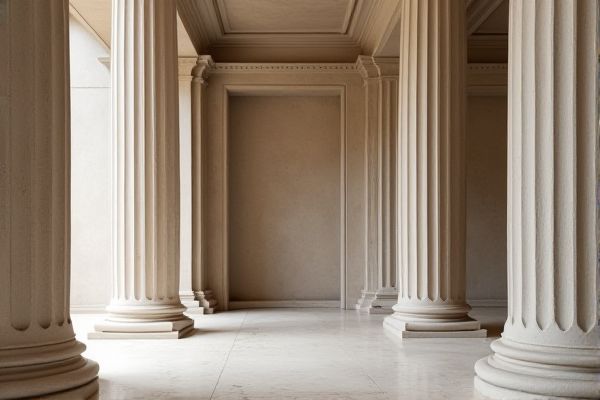
Tapered columns, characterized by their narrowing profile, offer a sleek and elegant look that enhances structural aesthetics, while square columns provide a more traditional, robust appearance favored for their simplicity and strength. Discover which column style best suits Your architectural needs by exploring the detailed comparison in the rest of the article.
Table of Comparison
| Feature | Tapered Column | Square Column |
|---|---|---|
| Shape | Conical, narrowing towards the top | Uniform, four equal flat sides |
| Structural Strength | Higher load distribution at base | Consistent load bearing throughout height |
| Material Usage | Efficient, less material at top | Uniform material use |
| Aesthetic Appeal | Elegant, classic architectural style | Simple, modern look |
| Construction Complexity | More complex formwork and shaping | Simple formwork, easier to construct |
| Cost | Generally higher due to complexity | Lower, cost-effective design |
| Common Uses | Monuments, temples, decorative structures | Commercial, residential, industrial buildings |
Introduction to Column Types
Tapered columns gradually decrease in width from base to top, offering an elegant profile ideal for architectural aesthetics and weight distribution in tall structures. Square columns provide uniform strength and support with a consistent cross-section, making them suitable for both load-bearing and decorative purposes. Your choice depends on the structural requirements and design preferences, balancing functionality with visual impact.
Defining Tapered Columns
Tapered columns feature a gradual reduction in cross-sectional size from the base to the top, enhancing structural efficiency and aesthetic appeal in architectural design. Unlike square columns with uniform dimensions, tapered columns optimize material use while supporting varying load distributions. Their distinctive shape allows improved resistance to bending and buckling forces, crucial in high-rise and bridge constructions.
Understanding Square Columns
Square columns are structural elements with a consistent cross-sectional shape, providing uniform load distribution and straightforward construction. Their geometric simplicity enhances stability, making them ideal for supporting beams and slabs in residential and commercial buildings. Unlike tapered columns, square columns maintain constant dimensions from base to top, simplifying formwork and reinforcing requirements.
Structural Performance Comparison
Tapered columns offer superior load distribution by gradually increasing cross-sectional area toward the base, enhancing structural stability and resistance to buckling compared to square columns. Square columns provide uniform strength but may experience higher stress concentrations at connections, potentially reducing overall resilience under dynamic loads. Your choice between tapered and square columns should consider the specific load demands and architectural requirements to optimize structural performance.
Aesthetic Appeal and Architectural Style
Tapered columns offer a sleek, elegant silhouette that enhances modern and contemporary architectural styles with their narrowing profile, creating a sense of height and sophistication. Square columns provide a sturdy, bold appearance that complements traditional, craftsman, and industrial designs, emphasizing clean lines and geometric precision. Your choice between tapered and square columns can significantly influence the overall aesthetic appeal, aligning the structure's style with your design vision.
Material Efficiency and Cost
Tapered columns optimize material usage by reducing cross-sectional area towards the top, leading to significant savings in concrete and steel compared to square columns with uniform dimensions. This reduction in material volume translates into lower overall costs, especially in high-rise construction where column mass impacts foundation size and structural load. Square columns, while easier to fabricate and formwork, tend to require more material throughout their height, increasing both material and transportation expenses.
Load Distribution and Stability
Tapered columns enhance load distribution by gradually transferring stress from the wider base to the narrower top, improving structural stability under varying loads. Square columns offer uniform load-bearing capacity with consistent cross-sectional area, providing predictable and reliable support for vertical loads. When designing your structure, tapered columns are advantageous for optimizing material use and stability, especially in buildings requiring resistance to lateral forces.
Applications in Modern Construction
Tapered columns are widely used in modern construction for architectural aesthetics and structural efficiency, particularly in high-rise buildings and bridges where load distribution and visual appeal are critical. Square columns are favored in residential and commercial buildings for their straightforward design, ease of fabrication, and compatibility with modular construction systems. Both column types contribute to seismic resilience and can be selected based on load requirements, architectural intent, and construction techniques.
Durability and Maintenance Considerations
Tapered columns, designed with a wider base that gradually narrows toward the top, generally distribute structural loads more efficiently, enhancing their durability under varying environmental stresses compared to square columns. Square columns, while easier to construct and maintain due to their uniform shape, may require more frequent surface treatments or protective coatings to prevent weathering and corrosion, particularly in harsh climates. Choosing between tapered and square columns should consider maintenance accessibility and long-term exposure factors to optimize structural longevity.
Choosing Between Tapered and Square Columns
Choosing between tapered and square columns depends on your architectural style and structural needs. Tapered columns provide an elegant, slender appearance that enhances visual interest and supports vertical loads with a wider base for stability. Square columns offer simplicity and strength, making them ideal for modern designs that prioritize clean lines and uniform load distribution.
 homyna.com
homyna.com